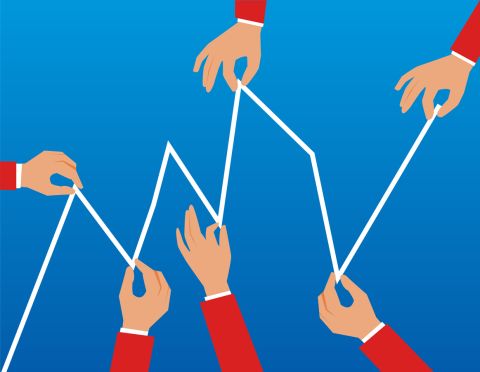
Research analysts have incentives to issue positive recommendations; social ties with fund managers exert considerable influence
The stock price of NASDAQ-listed Chinese education firm Hailiang Education Group (NASDAQ: HLG) has attracted scrutiny lately. From US$9.00 in the beginning of August 2017, the stock skyrocketed to over US$80.00 just eight months later. Market observers wondered if this was a classic pump-and-dump, and in August 2018 – exactly one year after its meteoric rise – prices started plummeting, breaching 52-week lows two weeks ago and garnering a “strong sell” recommendation from financial service website BidaskClub.
While there is so far no evidence of market manipulation or wrongdoing, the average Chinese investor’s relative lack of financial knowledge makes them vulnerable to such risks.
“In China, small investors make up the bulk of investors,” explained Gu Zhaoyang, Professor and Director at the School of Accountancy at The Chinese University of Hong Kong (CUHK) Business School. “They have neither the information nor the ability to process the information. Gu was speaking in a recent CUHK event in Singapore.
“[Research] analysts tend to influence investors because they issue reports for them to read. If you look at the trading behaviour, when analysts make a ‘sell’ recommendation people usually don’t sell. The stock price falls but there’s not much trading volume.
“But if an analyst makes a ‘buy’ recommendation, somehow people will buy. If that is the behaviour, and you buy, you do it through your brokerage account and the commission goes to your brokerage. So because people tend to trade more on good news rather than bad news, it’s natural for these analysts to generate brokerage fees with positive news.”
A symbiotic relationship
Gu also pointed out the symbiotic relationship between companies, fund managers and research analysts:
“In order to get [brokerage commission], these analysts issue reports for investors to read. Where do these analysts get the information? They get it from the managers at the firms which they cover. In order to gain relevant news about the company, the analysts curry favour with management by issuing positive recommendations to the market.
“The other is the investment banking relationship, the fee-generating relationship. The firm needs to go to the market to receive investment, be it an IPO or an M&A exercise. The deal will be handled by some investment banker or a brokerage. The analysts working at the investment bank or brokerage need to issue positive news to make the firm’s managers happy so that they’ll give them business.”
Similarly, fund managers under pressure to increase the value of their portfolio – and crucially, returns on investments – stand to benefit from positive analyst recommendations to buy, which translates to higher stock prices. In return, these fund managers help analysts become star analysts, leading to a big pay rise.
Gu elaborated: “Who votes on analysts becoming stars? It’s the institutional investors, the fund managers. Each fund gets one vote and each vote is weighted by the size of the fund. So if the analyst helps a fund manager push up his fund’s value, he could ask the fund manager to cast a vote in return to be a star analyst. It is possible for them to co-operate in this way, hurting small investors.”
In his research, Gu found that a stock’s price and a fund’s holdings of that same counter tend to be negatively related when affiliated analysts issue a “strong buy” recommendation. He added: “We find that a stock tends to shoot up following a ‘Strong buy’ recommendation by affiliated analysts. But from day 4 to day 30 or day 60 after the recommendation, the stock price tends to drop.
“The subsequent stock price fall suggests that the market does not fully realize the bias in affiliated analysts’ recommendations and factor it in the discount right away. Here the market takes up to 60 days to adjust. Indeed, we find that during this period fund managers are busy dumping the stock to small investors.”
Education and birthplace matter
The Chinese Wall seeks to maintain research independence by insulating research departments from other fee-generating departments within investment banks. While laudable, Gu questions its effectiveness when deals are lucrative. Moreover, independence of analysts is compromised by more subtle human relationships when people seek out others with similar backgrounds to work with.
“There are lots of fund managers who used to work at brokerages as analysts,” he pointed out. “And if you look at the schools they attended [and their hometowns], it’s the same university and provinces!” Specifically, the same five schools were the top five schools for analysts and fund managers:
- Fudan University;
- Tsinghua University;
- Peking University;
- Shanghai Jiao Tong University;
- Shanghai University of Finance and Economics
The top five provinces where analysts and fund managers were born? Jiangsu (江苏), Hubei (湖北), Shandong (山东), Hunan(湖南), and Anhui(安徽). Gu’s research showed that analysts with similar background to a fund manager were more likely to issue a “strong buy” recommendation for the stocks in the fund manager’s portfolio. Conversely, these managers were more likely to vote for an analyst who were from the same hometown or went the same school to be a star analyst.
What are the Chinese authorities doing to regulate such behaviour and protect small investors?
“One of the nice things about data in China is that, in certain aspects, it is more transparent than the U.S. For example, Chinese brokerage firms are required to disclose all commission fees, something that is not required in the U.S. It’s how we were able to study these things in China. This makes regulation of commission fees easier.
“However, regulation of more subtle human relationships, or guanxi (關係), is much harder, if not impossible.”
Follow us on Twitter (@sgsmuperspectiv) or like us on Facebook (https://www.facebook.com/PerspectivesAtSMU)
Last updated on 31 Jan 2019 .

